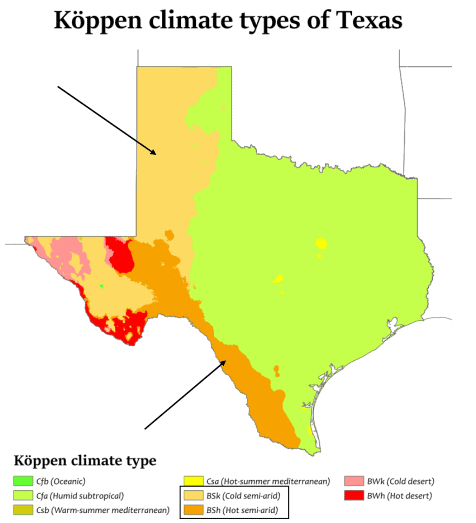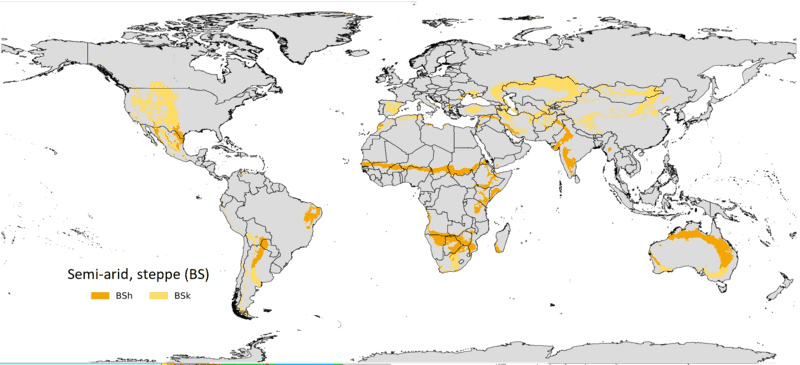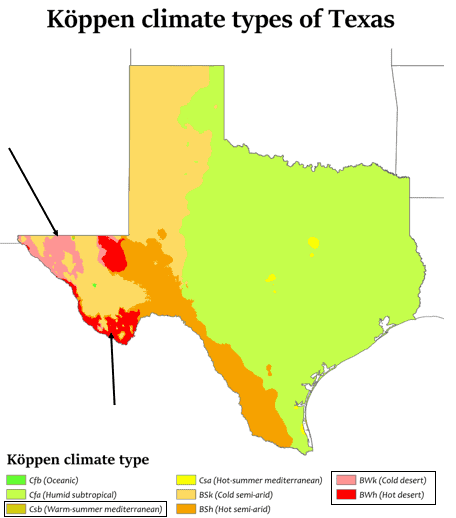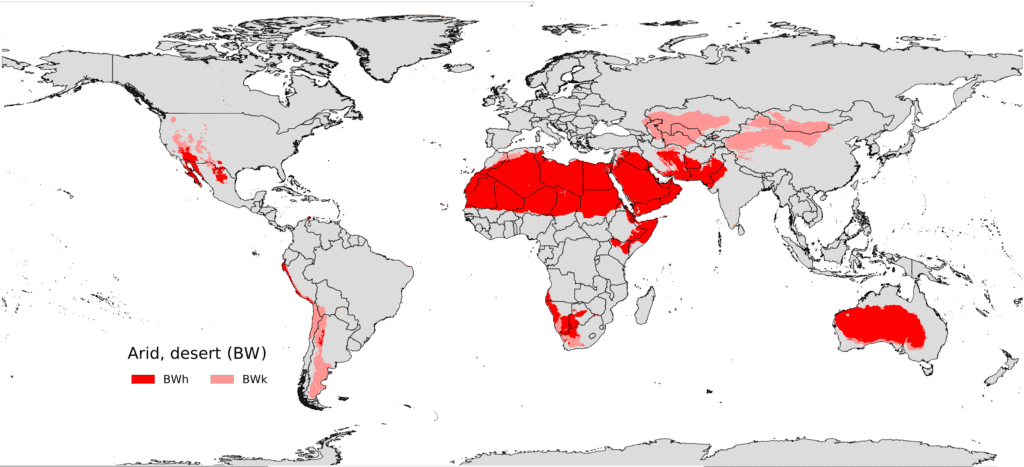Dry climate types occur in areas characterized by relatively small amounts of precipitation, in semi-arid and desert climate regions. In Texas alone, there are four distinct climate types that fall under the general “Dry climate classification,” including:
- Hot semi-arid (BSh),
- Cold semi-arid (BSk),
- Hot desert (BWh), and
- Cold desert (BWk).
See below for details regarding these distinct climate types and comparable areas around the globe with similar climates/weather patterns.
Semi-arid: Hot semi-arid (BSh) and Cold semi-arid (BSk)
Semi-arid climate types are defined by their extremely dry summers, with relatively little to no precipitation, with levels below evapotranspiration. However, the precipitation threshold for semi-arid areas does exceed precipitation levels for desert climate types. Climate types in Texas include both hot and cold semi-arid climates. Hot semi-arid climates (BSh) have annual temperatures that generally exceed 64℉/ 18ºC, marked by extremely hot/dry summers and warm winters. In contrast, cold semi-arid climates (BSk) have annual temperatures below 64℉/ 18ºC, and hot/dry summers, and cold winters.1Wikimedia Foundation. (2021, May 30). Semi-arid climate. Wikipedia. https://en.wikipedia.org/wiki/Semi-arid_climate
Identifying Characteristics for Hot Semi-Arid Climates2Wikimedia Foundation. (2021, May 30). Semi-arid climate. Wikipedia. https://en.wikipedia.org/wiki/Semi-arid_climate.
| Climate Group | B | Dry |
| Precipitation Pattern | S | Evapotranspiration exceeds precipitation (dry summers) |
| Average Summer Temperatures | h | Average annual temperatures meet/exceed 64℉/ 18ºC |
Identifying Characteristics for Cold Semi-Arid Climates3Wikimedia Foundation. (2021, May 30). Semi-arid climate. Wikipedia. https://en.wikipedia.org/wiki/Semi-arid_climate
| Climate Group | B | Dry |
| Precipitation Pattern | S | Evapotranspiration exceeds precipitation (dry summers) |
| Average Summer Temperatures | k | Average annual temperatures do not exceed 64℉/ 18ºC |


Other areas around the world that encompass hot semi-arid climates commonly include parts of Africa, Australia, South Asia. Areas that largely encompass cold semi-arid climates include Asia and North America as shown in this map.4Wikimedia Foundation. (2021, May 30). Semi-arid climate. Wikipedia. https://en.wikipedia.org/wiki/Semi-arid_climate
Desert: Hot desert (BWh) and Cold desert (BWk)
Desert climates have an excess of evapotranspiration over precipitation. They also fall under a calculated threshold of precipitation, used for differentiating semi-arid from desert climate types. However, aside from precipitation levels, semi-arid and desert climates are similar to one another. Hot desert climates (BWh) typically feature high temperatures year round, whereas cold desert climates (BWk) are marked by hot/dry summers and can experience very low temperatures during the winter. Cold desert climates are also frequently found in areas of higher latitude.5Wikimedia Foundation. (2021, May 5). Desert climate. Wikipedia. https://en.wikipedia.org/wiki/Desert_climate
Identifying Characteristics for Hot Desert Climates6Wikimedia Foundation. (2021, May 5). Desert climate. Wikipedia. https://en.wikipedia.org/wiki/Desert_climate
| Climate Group | B | Dry |
| Precipitation Pattern | W | Evapotranspiration exceeds precipitation (dry summers) |
| Average Summer Temperatures | h | Average annual temperatures meet/exceed 64℉/ 18ºC |
Identifying Characteristics for Cold Desert Climates7Wikimedia Foundation. (2021, May 5). Desert climate. Wikipedia. https://en.wikipedia.org/wiki/Desert_climate
| Climate Group | B | Dry |
| Precipitation Pattern | W | Evapotranspiration exceeds precipitation (dry summers) |
| Average Summer Temperatures | k | Average annual temperatures do not exceed 64℉/ 18ºC |


Other areas around the world that encompass hot desert climates commonly include deserts in parts of Africa, Australia, Middle East, and North America. Areas that largely encompass cold desert climates include parts of Asia, South America, South Africa and North America as shown in this map.8Wikimedia Foundation. (2021, May 5). Desert climate. Wikipedia. https://en.wikipedia.org/wiki/Desert_climate
True or False: Semi-arid climate types feature relatively little to no precipitation, with levels below evapotranspiration.
True
Correct.
False
Incorrect.
In Texas and around the globe, where are Cold desert climates typically encountered?
Areas of low latitudes
Incorrect.
Areas near the coast
Incorrect.
Areas of high latitudes
Correct.
Image Credits
- climate semi arid tex: Adapted by Ila Boley, Photo Courtesy of Adam Peterson, CC BY-SA 4.0, via Wikimedia Commons
- semi arid world climates: Maulucioni, based on a previous work by Beck, H.E. et al. 2018, CC BY-SA 4.0, via Wikimedia Commons